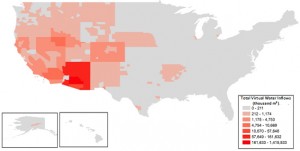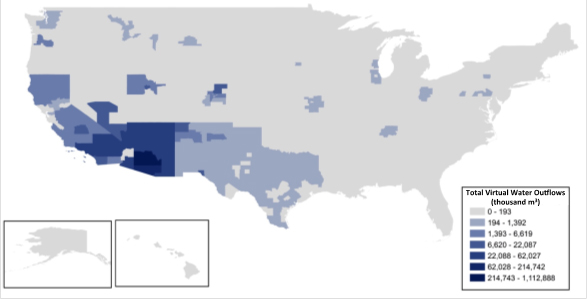
Arizona communities must cooperate to achieve water sustainability

The network graphic shows net virtual water dependency by Phoenix-area municipalities on their neighbors, in both labor (commuters) and commodity (food and other goods) categories. Phoenix is the most dependent, and Buckeye is the biggest supplier of virtual water within the metropolitan area.
Mapping the “water footprints” and “virtual water trade” of Arizona municipalities reveals some potentially big challenges for parts of the state’s largest metropolitan area under a forecast of continuing drought and reduced Colorado River allocations to Arizona.
Looming water cuts mean problems for agricultural towns and newer bedroom communities, but these water scarcity problems will be shared throughout Arizona through knock-on economic effects.
If development is curtailed on the edges of Phoenix, core communities and industries will feel the impact through a squeezed commuting labor supply. But the metro area’s cities and towns could meet this challenge with a spirit of neighborly cooperation in managing water resources.
The details are spelled out by Richard Rushforth and Benjamin Ruddell in their recent paper in the research journal Sustainability, “The Hydro-Economic Interdependency of Cities: Virtual Water Connections of the Phoenix, Arizona Metropolitan Area.”
Ruddell is an associate professor in the Polytechnic School, and Rushforth is a doctoral student in the School of Sustainable Engineering and the Built Environment. Both schools are part of the Ira A. Fulton Schools of Engineering at Arizona State University.
Their water-footprint endeavor has produced a detailed map of the hydro-economic network in the United States, called the National Water Economy Database.
“The network map for the Phoenix metropolitan area shows that these local communities are connected in more ways than they may have understood before. They need to recognize how heavily dependent they are on their neighboring cities’ water supplies” Ruddell said.

The heat map shows areas throughout the United States that are to varying degrees dependent on the Phoenix metropolitan area for virtual water supplies. Click on illustration to enlarge map.
“Your economic sustainability can be closely intertwined with your neighbor’s water sustainability,” explained Ruddell, who is also a senior sustainability scientist with ASU’s Global Institute of Sustainability. “The strongest connections to Arizona’s cities are close to home, with neighboring communities that share the same aquifers and river supplies. Because of these close connections, you can take a big hit to your water supply chain, even if your home city isn’t directly affected by a drought.”
The lesson provided by the research is that there are imbalances in the hydro-economic relationships between various regions and municipalities that will place unequal burdens on some communities during droughts – but everyone feels the indirect impacts through the network of connections.

The heat map shows areas throughout the United States that the Phoenix metropolitan area depends on for its virtual water supply. Click on illustration to enlarge map.
Core communities such as the city of Phoenix would need more water to supply homes and farms if they didn’t outsource that water use to their nearby neighbors. But Phoenix will be impacted if its neighbors suffer from drought—even if Phoenix has planned for water sustainability and has no problems of its own with water supply.
Arizona’s communities need to protect themselves by working together with their neighbors on water supply problems, and by diversifying their water supply chain to avoid excess exposure to risk of drought in any one location, such as California, the Lower Colorado River or neighboring communities that share the same water supply, Ruddell said.
Applications of this data to solve municipal water management problems are detailed in a second paper recently published in the journal Sustainability, “Water Footprint of Cities: A Review and Suggestions for Future Research,” authored by a team of researchers including Ruddell and Rushforth.
The research conducted to reveal the water resource connections among Arizona cities is motivated by the goals of the Central Arizona–Phoenix Long-Term Ecological Research program led by ASU researchers. The program is supported by the National Science Foundation to study the urban ecology of the Phoenix metropolitan area and the surrounding Sonoran Desert region.
By Joe Kullman



































